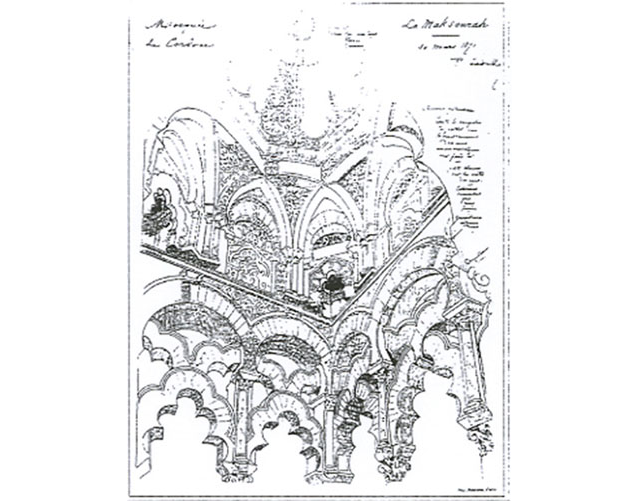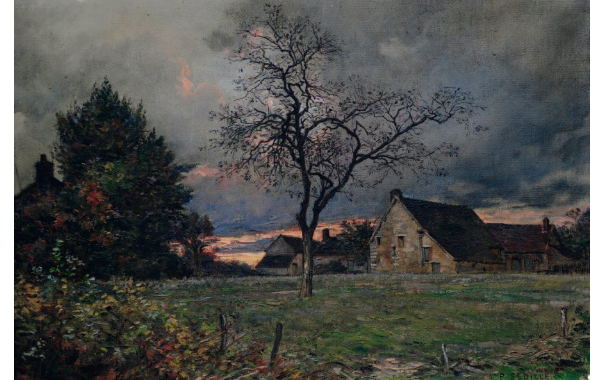Paul Sédille
1836 -1900
His beginnings
Born in Paris in 1836, Paul Sédille studies in the École des Beaux-Arts of Paris between 1857 and 1869 and becomes the student of his father, the architect Jules Sédille (1806 – 1871), but also of Hippolyte Le Bas (1782 – 1867) and Jean-François Guénepin (1807 -1888).
Paul Sédille was not only an architect, he was also a theoricist and wrote many articles on the European architecture of his time. Also paintor, he exhibits each year, between 1867 and 1888, his paintings made in the Barbizon school line, in the Salon des artistes Français, in Paris.
A revelation : the trip to Spain
In 1871, he decides to leave for Spain. This trip was very important for him as he became aware of the architectural polychromy importance.
Wanted to discover the moorish art in Granada, Sevilla or Cordova, he’s there extremely impressed by the polychrome monuments presenting an abstract and floral decoration, with simplified shades ranges.
For the architect, it was a dazzle in each visit, to the Alhambra in Granada, to the Alcazar or the Casa of Pilatos in Sevilla, and more in the mosque of Cordova. Inside the mosque, the Mirhab and the Maksourah, gave to architect intensive emotions.
About the Maksourah’s mosaics, he wrote : « This mosaic, composed of very small glass cubes, adorned with beautiful Kufic scripts and arabesques from the most elegant and noble drawing detaching on gold and azur backgrounds, is harmony and richness of shades, superior to all that Venice, Roma or Ravenna can offer in this kind of works. This mosaic is really sister of braided and embroded wonders by the oriental genius ».
He spent there hours drawing and covering his notebooks with notes.
The influence of this travel was almost immediate on Sedille.
The polychromatic architecture
Since 1871, he tirelessly defended the principle of a colored architecture in the wake of Hittorff, and repeated that the polychromy was an universal principle of the architecture, and its oblivion in France since the 17th century could only be temporary.
He reminded that the Greek and Roman architecture was polychrome ; called on Viollet-le-Duc’s works on Notre-Dame of Paris relative to his restitution of the interior and exterior colors tries ; or even the della Robbia earthenwares corresponding to the idea he has of architectural ceramic.
The color was used as an expressive complement for the architectural form and to demonstrate it, Sédille do not hesitate to call on during his conferences Mexico, Peru or the enameled decorations.
Nevertheless, it’s mainly the East that gives him the essential base of his demonstrations, as many other modern artists. The fascination for the East knows a regain in the Occident since the 19th century, especially with the Romantism mouvement.
Sédille was attentive all his life to the archeological researches lead in North Africa and in the Middle East because they give him substance for his reflection on the monumental polychromy.
Beginning of the collaboration Sédille / Loebnitz
It’s from 1871 that Jules Loebnitz orientated his production toward the architectural decoration, especially under the push of his friend Paul Sédille, recently back from his travel in Spain. Between the two men, was born a true friendship which engages them in a close collaboration as professional as intellectual.
Paul Sédille’s intimate conviction was that the ceramic medium was the king of polychrome architecture materials and Jules Loebnitz’ earthenware satisfied this ideal. To him, modern polychrome needed to last as long as the building, which made his collaboration with Loebnitz so interesting.
The common dream between Sédille and Loebnitz is translated by the will for one of a polychrome architecture made possible by the architectural ceramic of the other. Loebnitz knew how to use non crackable earthenware able to resist to exterior thermical shocks while offering a perfect support to traditional enamels. The architectural ceramic was born.
According to what he saw, especially in Sevilla, Paul Sédille gave to Jules Loebnitz Arabic models that were used to different architectural projects born form their collaboration : Exhibitions pavillions, buildings, villas, hotels or commemorative monuments.

Jules Loebnitz and Paul Sédille, Moorish conservatory
World Fair
His work was particularly noticed during the 1878 World Fair. He built for the occasion in collaboration with Jules Loebnitz, the monumental door of the Beaux-Arts pavillion.
It was described by a reporter of the fair like this : « Nothing is beautiful as the monumental door made by sir Loebnitz and exhibited under the porch of the Beaux-Arts, from a projects by Paul Sédille […] everything is there spectacular , with an elegant and clever decoration, and enamel that could brave the humid temperature of our winters […] ».
Indeed, the door of the Beaux-Arts section, drawn by Sedille, was composed of earthenware elements executed by Loebnitz. Their collaboration was rewarded by a gold medal.
Lœbnitz's workshop renovation
Jules Lœbnitz asked Paul Sédille to renovate his workshops located on the 4 rue de la Pierre-Levée in Paris, between 1880 and 1884. The facade was adorned with large ceramics panels from Lévy’s drawings, who won the Grand Prix of Roma.
L'Exposition de l'Union Centrale des Arts Décoratifs
« It suits to adroitly match the ceramics with other materials and to associate in a harmonious range of shades the c convient de marier habilement les céramiques avec les autres matériaux et surtout de les associer dans une gamme harmonieuse les colorations puissantes de vos émaux », tels étaient les conseils que promulguait Paul Sédille à son ami Jules Loebnitz à l’occasion de l’Exposition Universelle Internationale de 1889 à Paris.
Lors de cette même exposition, Loebnitz présentait en tant que membre du jury une « exposition de décoration céramique appliquée à l’architecture », soit un « élégant portique orné d’émaux et de terres cuites. La pièce principale était une cheminée monumentale en briques apparentes, ornée de décors émaillées et comportant sous la voussure deux groupes de personnages grandeur nature en terre cuite de ton naturel ; architecture de M. Paul Sédille, figures d’André Allar ».
L’exposition du 1889 fut l’apogée du fer et l’âge d’or de la céramique.
Architecte of the Printemps
On the 9th of March 1881, the Parisian department store Au Printemps founded in 1863 by Jules Jaluzot (1834 – 1916) was destroyed by a terrible fire. The reconstruction was given to Paul Sédille whom had made with his father, the architect Jules Sédille, the original building on the ground floor of which was the first Printemps.
For the making of this construction which spreads between 1881 and 1889, a precise programm was given to the architect, « to rebuild the stores on a plan including now the whole block envelopped by the boulevard Haussmann, the rue du Havre, the rue de Provence and the rue Caumartin, then proceed by construction lot, starting with facade on the rue du Havre, to temporarly continue the sell in the inferior parts of the building that the fire hasn’t completely destroyed».
Jules Loebnitz's grave
After the death of Jules Loebnitz, Paul Sédille gave his friend a last homage to their friendship and collaboration by making his grave located in the Père Lachaise cemetery. The sculptor André Allar, also friend with the two artists, participated by making the terra cotta medallion on which is represented the portrait of the deceased.
World Fair
For the 1900 World Fair, Sédille collaborated with the son of his deceased friend, Jules-Alphonse Loebnitz, whom had taken the direction of the ceramic manufactory. Both have realized a fountain surrounded by a pinnacle which was place outside of the fair.
Discover our other websites
dedicated to houses and artists from the second half of the 19th century
Théodore Deck
L'Escalier de Cristal
Tusey foundries
Fourdinois
Gentil & Bourdet
Victor Geoffroy-Dechaume
Henri Husson
Alfred Janniot
Jules Loebnitz
Perret & Vibert
J-Nicolas Rivart
Gabriel Viardot
Find us
120 rue des Rosiers 93400

+33 (0)6 60 62 61 90

contact@marcmaison.com

Copyright © Marc Maison | 2021
Privacy politic





